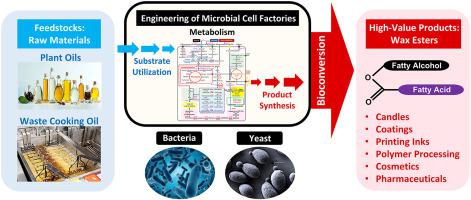Metabolic Engineering ( IF 6.8 ) Pub Date : 2021-08-13 , DOI: 10.1016/j.ymben.2021.08.002 Ya-Hue Valerie Soong 1 , Le Zhao 2 , Na Liu 1 , Peng Yu 1 , Carmen Lopez 2 , Andrew Olson 1 , Hsi-Wu Wong 1 , Zengyi Shao 2 , Dongming Xie 1

|
Microbial synthesis of wax esters (WE) from low-cost renewable and sustainable feedstocks is a promising path to achieve cost-effectiveness in biomanufacturing. WE are industrially high-value molecules, which are widely used for applications in chemical, pharmaceutical, and food industries. Since the natural WE resources are limited, the WE production mostly rely on chemical synthesis from rather expensive starting materials, and therefore solution are sought from development of efficient microbial cell factories. Here we report to engineer the yeast Yarrowia lipolytica and bacterium Escherichia coli to produce WE at the highest level up to date. First, the key genes encoding fatty acyl-CoA reductases and wax ester synthase from different sources were investigated, and the expression system for two different Y. lipolytica hosts were compared and optimized for enhanced WE production and the strain stability. To improve the metabolic pathway efficiency, different carbon sources including glucose, free fatty acid, soybean oil, and waste cooking oil (WCO) were compared, and the corresponding pathway engineering strategies were optimized. It was found that using a lipid substrate such as WCO to replace glucose led to a 60-fold increase in WE production. The engineered yeast was able to produce 7.6 g/L WE with a yield of 0.31 (g/g) from WCO within 120 h and the produced WE contributed to 57% of the yeast DCW. After that, E. coli BL21(DE3), with a faster growth rate than the yeast, was engineered to significantly improve the WE production rate. Optimization of the expression system and the substrate feeding strategies led to production of 3.7–4.0 g/L WE within 40 h in a 1-L bioreactor. The predominant intracellular WE produced by both Y. lipolytica and E. coli in the presence of hydrophobic substrates as sole carbon sources were C36, C34 and C32, in an order of decreasing abundance and with a large proportion being unsaturated. This work paved the way for the biomanufacturing of WE at a large scale.
中文翻译:

蜡酯的微生物合成
从低成本的可再生和可持续原料中微生物合成蜡酯 (WE) 是实现生物制造成本效益的有希望的途径。WE 是工业上的高价值分子,广泛用于化学、制药和食品行业。由于天然 WE 资源有限,WE 的生产主要依赖于从相当昂贵的起始原料进行化学合成,因此需要通过开发高效的微生物细胞工厂来寻求解决方案。在这里,我们报告设计酵母解脂耶氏酵母和大肠杆菌以最新的最高水平生产 WE。首先,研究了编码不同来源的脂肪酰基辅酶A还原酶和蜡酯合酶的关键基因,以及两种不同解脂耶氏酵母的表达系统对宿主进行了比较和优化,以提高 WE 生产和应变稳定性。为了提高代谢途径效率,比较了葡萄糖、游离脂肪酸、大豆油和废食用油(WCO)等不同碳源,并优化了相应的途径工程策略。发现使用脂质底物如 WCO 代替葡萄糖导致 WE 产量增加 60 倍。工程酵母能够在 120 小时内从 WCO 以 0.31 (g/g) 的产量生产 7.6 g/L WE,并且生产的 WE 贡献了酵母 DCW 的 57%。之后,大肠杆菌BL21(DE3) 具有比酵母更快的生长速度,旨在显着提高 WE 生产率。表达系统和底物进料策略的优化导致在 1-L 生物反应器中 40 小时内产生 3.7-4.0 g/L WE。在疏水底物作为唯一碳源存在的情况下,解脂耶氏酵母和大肠杆菌产生的主要细胞内 WE是 C 36、C 34和 C 32,按丰度递减的顺序排列,大部分是不饱和的。这项工作为 WE 的大规模生物制造铺平了道路。











































 京公网安备 11010802027423号
京公网安备 11010802027423号